Genre: Action Developer: Nextgrand Publisher: Ballistic Players: 1 Released: 1991
At the dawn of the 1990s, a new title took the 16-bit gaming world by storm. The protagonist, a heroic warrior with godlike powers, was tasked with singlehandedly defeating legions of evil armies in an effort to unify the land under one benevolent banner. Combining the cerebral, patient play of an overhead strategy/role-playing title with the visceral excitement of a side-scrolling action platformer, the game boasted detailed graphics, a gorgeous soundtrack, wonderfully grotesque bosses, and addictive and varied gameplay that even included elements of a shooter. It had been previously published overseas, but met with resounding success once it was released in the United States. It turned out to be one of the early flagship titles on the relatively new 16-bit platform, and remains among the system’s true classics.
And that game…was ActRaiser for Super Nintendo.
But you can say many of the same things about Onslaught – provided that you redact every one of the positive adjectives. For unlike its SNES colleague, Onslaught is a dire fraud of a game, and fails in every way to live up to the promise of its concept.
Originally released for the Amiga in 1989, and then ported to the Genesis in 1991, Onslaught seems to have been resoundingly ignored by Sega gamers, and rightly so. This has made it somewhat expensive and hard to find, especially in complete form. My review is partly written to discourage anyone from spending their money on Onslaught in hopes of unearthing a hidden gem in the Genesis library.
For many gamers, Onslaught starts out with a big strike against it, though in truth it’s not really the game’s fault. Like Budokan, Ishido, Populous, and Zany Golf, all of which were developed without a license from Sega, it will not boot on any Genesis system with the TradeMark Security System (TMSS) that Sega introduced in 1991 to lock out unlicensed game developers. This affects all Model 2 and Nomad systems, and most late Model 1 systems as well, though in all cases the lockout can be bypassed by using a Game Genie as a passthrough. (However, Onslaught is still unplayable on Nomad systems, for another reason that I’ll detail below.)
If you are able to boot Onslaught, it might make a favorable impression at first. The title screen is attractive enough, the music seems respectable, and once you begin the game itself, you’re greeted with a detailed and reasonably intelligible map that shows your warrior’s name, religious affiliation (“cult”), and other statistics. Your mission is to conquer all 104 territories of the land of Gargore, fighting on behalf of Prince Balthusar, whose noble father was killed by Gargorian troops.
Your warrior, who is randomly selected from among Balthusar’s elite warriors, begins in the single territory you control near the center of the 16×16 map. From there, you can immediately initiate combat with enemy forces in the next territory, or attack a nearby Water Temple. Choosing either of these options triggers a flashy, animated splash screen which announces your intentions, e.g. “GRIMUZ ATTACKS THE KINGDOM OF GRODROT”.
Here, the merits of Onslaught‘s presentation begin to crack. If you’ve launched an attack on the enemy, you’re dropped into a side-scrolling battle scene of medieval ramparts bedecked with corpses and rickety ladders, as enemy warriors immediately begin pouring in from the right. The graphics are colorful and crisp, the soundtrack is active, and the sound effects…hmmm…where are the sound effects, exactly?
Well, it turns out that Onslaught‘s developers have offered you the same choice Amiga gamers enjoyed throughout the 1980s and 1990s: you can have music, or sound effects, but not both. A selection from the starting menu forces you to pick one or the other. It’s hard to believe this is a technical requirement on the Genesis, and it certainly robs the game of atmosphere.
Whichever choice you make, once you begin to engage the enemy and explore the landscape, you’ll soon discover another hallmark of Amiga gaming: pressing Up to jump. The B button is used to attack or activate an item, while the A and C buttons are used to select which weapon or item you’re using, so there’s nothing left but Up. In fairness, this isn’t much of a problem since there’s no real platforming in the game, but it’s another bad sign.
The basic gameplay in Onslaught‘s battle scenes is essentially “capture the flag”. Your job is to reach the enemy’s flag at the far right of each stage; theirs is to capture yours at the starting point. Defeat comes from letting enemies bypass your attacks and exit the left side of the screen. An onscreen meter keeps track of their numbers, and if it reaches the top, Balthusar’s appointed warrior loses the battle and is forced onto the defensive. Meanwhile, he can achieve victory merely by touching the enemy’s flag (and surviving long enough for the enemy meter to return to zero).
Your warrior has a vast array of weaponry ranging from simple maces, to heat-seeking demon heads, to magical spells that instantly kill all onscreen enemies. This armory is constantly being used up and replenished, since practically every defeated foe drops an item. The player can manually select each item before use (which is clumsy), or have the game automatically manage your arsenal. The game generally chooses well, but will often select weapons that are more hindrance than help, forcing you to use them up before getting a better option.
Meanwhile, the adversary has the advantage of numbers, augmented by fast-moving cavalry and mobile fortifications that take multiple hits to destroy. In addition, they’ve placed landmines, stationary artillery posts, and even suicide bombers in your way, depending on the type of Warband defending the territory. All of these things can damage your Life and Energy, and if either of those meters are reduced to zero, the game immediately ends.
If you win the initial field battle, you begin a second siege battle that’s essentially the same, but fought on somewhat different terrain. Win that battle as well, and you have a Mind Duel – a psychic showdown with the opposing leader. This Mind Duel is a simplistic “tube shooter” vaguely akin to Tempest or Gyruss. Your opponent manifests as a grotesque, four-armed beast, while you’re now depicted as a hand that takes up residence at the edge of the screen. Your foe fires a steady volley of lethal projectiles towards you, while you’re capable of firing at a much faster rate, but do far less damage per shot. Occasionally healing items appear at the edge of the screen, but otherwise it’s a war of attrition in which you’re trying to destroy the enemy’s arms while dodging his constant attacks. Win this Mind Duel, and you win the territory; lose, and you’re pushed back to the preceding Siege. Without any setbacks, the whole process takes 5 to 10 minutes per territory.
There are four different kinds of temple in the game, and an attack on these goes straight to a Mind Duel. Here, you can acquire important Talismans that allow you to cross impassable terrain, eliminate plagues or uprisings from conquered territory, and even instantly conquer a territory without a fight. Many of these only appear during an extended battle, however, so you’ll have to dodge the Temple Guardian’s projectiles while waiting for the Talisman you need.
All this sounds impressive on paper, and indeed, the first 15 minutes or so of Onslaught are reasonably fun. The gameplay is unabashedly shallow from the start, amounting to little more than “hold right and keep pressing B”, but there’s always a lot of activity. You can unleash a devastating amount of firepower that far exceeds the enemy’s arsenal – it’s not uncommon to kill multiple enemies per second – and the game displays a large number of moving objects with very little slowdown.
The Mind Duels can intimidate a new player, but rapid button-mashing works reasonably well at first, and with practice a precision approach helps you wait for the right Talisman. Meanwhile, you gradually gain social status through the side-scrolling battles, starting out as “Scum” and working your way up to “Emperor”. (These titles are score-based, and don’t seem to have any in-game effect.)
Any enjoyment, however, comes to a screeching halt once you realize that, in Onslaught, every single battle is the same. Sure, there’s some slight variation depending on the Warband you’re fighting; some groups have cannons, others have horses or rolling fortresses, and if you attack a plague-ridden area, you can even battle an undead army. And the game’s manual conveys the expectation of depth, with a lengthy discussion of gameplay and backstory that even describes the various gods worshipped by the citizens of Gargore.
But in reality, there’s absolutely no depth to Onslaught: no progression, no growth, no difficulty curve, nothing. Every Field or Siege stage is laid out identically, with both flags in the same places. Enemies spawn in the same predictable patterns. Even the item drops are completely deterministic – a red scroll will always be followed by a blue scroll, and so on. The statistics for each territory, like Popularity and Population, have no discernible effect. And the same goes for Mind Duels: the enemy or the background might look a bit different, but it’s just cosmetic – the attack patterns, item drops, and all other aspects of the gameplay are always the same.
With perfect play, conquering Onslaught’s 104 territories would mean playing through over 200 identical side-scrolling Battles, and over 100 identical Mind Duels. Simply put, this is beyond preposterous – it’s downright insulting to the player, and makes the game an absurd waste of time. And there are no rewards along the way to help encourage the weary warrior, not the faintest whisper of a cutscene, new character or item, or anything else (unless you count the game’s useless Oracle, whose hopelessly banal advice is only available on higher difficulty levels: a bizarre decision since, by that point, the player won’t need it).
My first playthrough of Onslaught was on amateur level, took over eight hours in multiple sessions, and was every bit as mind-numbingly repetitive as you might imagine. However, I found a clever trick to beat Professional level in under two hours, without fighting a single side-scrolling battle (giving me a final score of zero!). Anyone who reads this review carefully can guess how to pull this off; it only requires a little patience and a willingness to dodge projectiles.
I should also mention Onslaught‘s amazingly unintuitive password system. To get a password during gameplay, or at a GAME OVER screen, you have to hit Reset (that’s what makes the game unplayable on a Sega Nomad, which has no Reset button). When the game reboots, the menu will be replaced with a readout of your password. Naturally, the game’s font is quite difficult to read; naturally, it doesn’t automatically preload the password, forcing you to re-enter it from scratch if you simply wanted to write it down and keep playing. And of course, the password doesn’t track anything except your score and the aggregate number of territories you’ve conquered – not even your warrior’s name and religion remain constant from session to session.
The inevitable conclusion is that Onslaught is an inexcusably poor game. One might look for something to admire in its graphics or soundtrack, but any positives are neutralized by huge flaws in the game’s presentation. Even that is irrelevant, though, because the overriding issue is that Onslaught is repetitive and shallow beyond all hope of redemption. There literally isn’t anything to do but fight the same battles hundreds of times in a row. It’s a data-entry job masquerading as a video game, a mindless Pavlovian exercise pretending to be a fun diversion. It is utterly without merit or satisfaction, and should never have been released for the Genesis.
SCORE: 1 out of 10

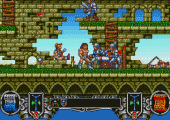
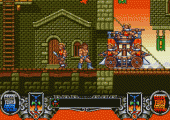
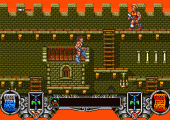
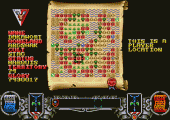
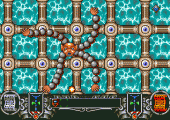
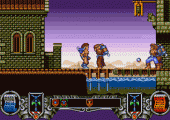
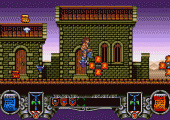
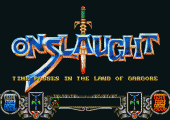
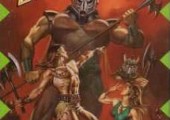
Recent Comments